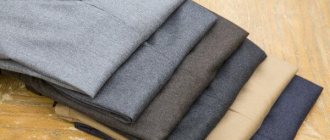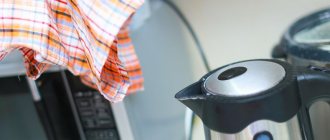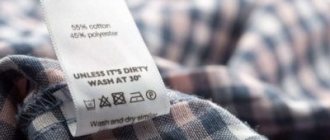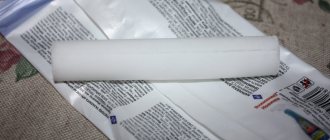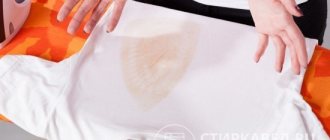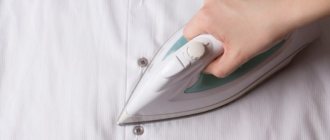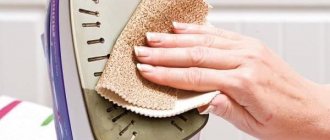Most modern electric irons with a thermostat have three operating modes, each of which is designed for a specific type of fabric. The temperature parameters are divided as follows:
- for nylon and silk: minimum – 75 °C, maximum – 115 °C, nominal – 95 °C;
- for wool: minimum – 105 °C, maximum – 155 °C, nominal – 130 °C;
- for cotton and linen: minimum – 145 °C, maximum – 205 °C, nominal – 175 °C.
The minimum temperature mode is indicated by one dot on the thermostat, the average mode by two dots, and the high temperature mode by three.
Help: in order not to make a mistake with the choice of temperature, you need to pay attention to the product label, which indicates the maximum permissible value.
Temperature modes: deciphering the points on the temperature controller
If you choose the wrong ironing mode, nylon or chiffon fabric can be singed through, while linen or cotton fabric will remain wrinkled. So that the user can select the desired temperature, the iron is equipped with a “handle” or “rotary wheel” that regulates the thermostat. Images corresponding to a certain temperature regime were applied to the handle. In most cases these are points. The more there are, the higher the heating temperature of the sole surface.
The selected temperature regime must comply with the rules for caring for the item. For user convenience, they are printed on product labels in the form of pictures. The graphic rules also have repeated dots: one, two or three. Such images are not random, each means a certain ironing mode.
One
The single mode means that the heating temperature allows you to iron fabrics that require delicate care:
- silk,
- chiffon,
- nylon,
- acetate,
- polyamide,
- viscose,
- nylon
The material will be exposed to temperatures up to 110 ˚С.
Sometimes there is an inscription “nylon”, “silk” nearby, confirming the choice of the most delicate mode.
Two
To perfectly iron more heat-resistant fabrics, you will need to set the wheel to 2 points. This temperature mode is suitable for:
- polyester;
- wool,
- half-wool.
The exposure temperature will be up to 150˚C. You can often find the designation “wool” (for wool) nearby.
At this t, steam ironing is possible.
Three
The following fabrics require maximum heating when ironing:
- linen,
- cotton,
- tweed,
- drape
Thermal exposure reaches 200 ˚С. The ironing process is made easier by the possibility of exposure to steam.
What do the rest of the heat treatment symbols mean?
Other modes are presented in the table:
Although there are no such signs on the electrical appliance itself, they make it clear whether it is worth turning on the steam and how many “points” to stop at when ironing.
What can the icons on the label tell us?
The label on things is a kind of instruction on how to care for it. Acceptable ironing modes are shown in the form of an iron in different designs:
Ironing image - the material tolerates ironing well with an electric iron. Machine ironing is acceptable. An iron with three points in the middle - textiles can be ironed with an iron heated to a temperature of 200 degrees (for example, for items made of cotton and linen). Ironing in a circle - ironing temperature no more than 140 degrees. If the electric iron does not have a temperature indicator, you should set the slider to approximately the middle. Iron with two points inside - the maximum temperature of the iron is 130 degrees. These are things made from fabrics such as polyester, polyester, silk, wool, viscose. An iron with one point inside - the permissible ironing temperature does not exceed 120 degrees. This mode is used for delicate fabrics
Ironing should be done with extreme care and precision. A crossed out iron means the item cannot be ironed! Moreover, not only with an iron, but also with a steam generator. Iron with steam crossed out - this sign indicates that steam treatment of the product is prohibited.
These markings make it possible to select the appropriate ironing mode for the product.
Important! Ironing begins with lower degrees of iron temperature, gradually increasing it
Recommendations for choosing ironing temperature for different fabrics
There is often a situation where there is no label with care instructions on items. In these cases, practical advice will come in handy.
Linen
The item must first be turned inside out and ironed at a temperature of 180-200 °C. The best results are achieved when the fabric is damp. During the ironing process, do not be afraid to apply pressure to the iron and use steam.
If the item contains an admixture of cotton, then the iron should not be heated above 180 °C. It is worth considering that decorative elements (for example, embroidery) are often made of synthetic materials, so they should be ironed only from the inside out.
What to do if the material is very dense and cannot be ironed properly? Such items are additionally ironed on the front side, possibly at the same temperature, but always through gauze. If the product is starched, then the temperature must be reduced by 10 - 20 degrees.
Wool
Wool does not tolerate high temperatures, so the optimal temperature for it is 100 – 120 °C. This applies to woven wool, and it is better not to iron knitted items at all. If you really want to iron your favorite sweater, then you need to do it from the inside out, without pressing the iron, so as not to stretch the material. A drape coat is ironed at 140 -170 °C, always with steaming.
Cotton
This material should be ironed at a temperature of 170 - 180 degrees. Like linen, it is better to process cotton when it is not yet completely dry, or to pre-moisten it with a spray bottle. Steaming can be used.
Silk
This is a very delicate material that should be ironed as carefully as possible. It does not tolerate temperatures above 60 - 80 ° C, as well as steaming. If it becomes necessary to iron through fabric, then you should use thin cotton, but not gauze (it can leave unsightly marks on a silk product). When processing through fabric, the temperature can be increased by 20 °C.
Viscose
The maximum temperature is 120 °C, light steaming is allowed.
Knitwear
Temperature – medium or minimum. To avoid stretching the fabric, it is better to steam knitwear in a vertical position instead of ironing.
Manufacturers
In 2022, the iron market is captured by giants producing household appliances. Large manufacturers not only set pricing policies, but also maintain quality standards.
Products from the following companies have advanced technologies and high reliability:
- Philips,
- Tefal,
- Brown,
- Bosch,
- Rowenta.
However, the price for such devices is not the lowest; you can hardly expect that you will find a device from Philips for 1 thousand rubles. But this is not a reason to be upset. There are good brands that produce decent quality equipment in the budget segment:
- Vitek,
- Scarlett,
- Maxwell,
- Polaris,
- Supra.
Think, maybe a simpler, but less “famous” model is enough for you? You will have to pay extra for a high-profile brand.
How many degrees does the iron heat up to?
For fabrics that are most difficult to iron, it is necessary to use a maximum iron heating temperature in degrees equal to 205˚C. In this case, the heating rate will depend on the type of material from which the sole of the iron is made, and the power of the electrical appliance.
Heating rate depending on sole material
The sole is made from:
- Aluminum. Heating occurs very quickly, and cooling also occurs, but the material is short-lived. Hard elements on clothing can leave scratches in which burnt-on fabric particles become embedded.
- Of stainless steel. It heats up quickly, glides well over the surface, and is durable. The disadvantage is the heavy weight of the device.
- Ceramics. This coating is applied to a metal base. It glides perfectly, allows you to iron fabric in hard-to-reach places, and does not catch clothes. Heating and cooling take longer. Ceramic retains heat, so even when turned off, the iron remains on for 8-10 minutes. stays hot. The disadvantage is the fragility of ceramics, susceptibility to chips and damage. To extend service life, manufacturers use cermets.
- Teflon - reliably protects clothes from burning, but does not last long. The Teflon surface does not glide well over fabric, making ironing difficult.
- Sapphire is a specially developed alloy that gives the sole extra strength. Conducts heat well.
- Titanium is rarely used in the production of household irons. The metal will heat up quickly and take a long time to cool down. The surface strength is not inferior to steel.
Maximum temperatures in different models may vary, so before choosing a mode, you should read the instructions.
If the iron has only one heating mode, there is no spray and steam function, the temperature of the iron sole will be 115˚C (±10).
Irons with a drip system are slightly hotter - about 155˚C.
Electrical appliances with the possibility of steam processing reach temperatures of 175-205 ˚C.
Influence of electrical appliance power
The speed of heating the surface, the possibility of supplying a “cloud” of steam, and the speed of cooling of the sole directly during ironing depend on the power of the iron.
In household models, the power ranges from 800 to 2200 W. Models that are not equipped with a thermostat and a humidifier have a lower power - within 400 W. Ironing them is much more difficult; they heat up more slowly and cool quickly.
Advice! An iron with a power of 1500 to 2200 W is suitable for household use. For those who like to iron a large number of items with maximum comfort, models with a power close to 2700-2800 W are suitable, but you should make sure that the wiring can withstand this voltage and do not turn on several electrical appliances at the same time.
Professional ironing for many hours, for example, in a laundry or dry cleaning, will require the purchase of a more expensive and powerful device - from 2800 W. Heating in such models occurs as quickly as possible, and the steam boost is extremely powerful (about 230 g/min).
Minimum iron temperature
To select the lowest temperature, you must select the “silk” ironing mode (one point). The minimum ironing temperature is 75˚C.
In irons without a thermostat, the heating temperature is about 115 °C. Since it is impossible to select a delicate treatment mode for the product, you should start ironing from the wrong side, moistening the fabric.
When straightening an item that cannot be ironed, even the mode set to one point can ruin it. To safely process fabric you must:
- moisten it with a spray bottle and hang it for leveling;
- apply steam;
- iron, placing the item between two layers of fabric: dry on the bottom, wet on top.
Advice! Before steam treatment, you need to make sure that no rust particles or drops of water come out of the nozzles, which can leave streaks. A removable attachment on the soleplate of the iron will help prevent contamination.
Steam temperature in the iron
Steam helps to moisten the item and makes it much easier to straighten the fabric, but for particularly wrinkled areas, a “steam boost” is used. The feed intensity depends on the power of the iron.
In household models, the steam force is about 20-25 g/min. More professional equipment allows you to use steam supplied at an intensity of 160 g/min. In this case, the steam temperature reaches 160-210 ˚С depending on the characteristics of the model.
Device
Iron components:
- Heating element. A nichrome spiral with ceramic rings through which current flows through the power cord. This leads to heating of the coil and sole.
- Thermostat. Allows you to select the ironing mode for each type of fabric. The appearance resembles a wheel. It is located on the body of the device. As soon as the soleplate heats up to the marked temperature, the electrical circuit opens and the voltage stops supplying.
- Electrical wire. Consists of three insulating plastic cores. One of them acts as a grounding conductor to reduce the possible risk of electric shock. In addition to plastic, the wire is braided with fabric. This way the polymer shell will not fray and the device will last longer.
- Steam supply system (if available). It is usually controlled using two keys on the handle. The first controls the output of hot air. When you press it, a certain portion of steam will flow to the sole. The second button is responsible for spraying water. This is done so that the wrinkled fabric can be smoothed out more easily.
- Sole. Serves as a working surface for the iron. The efficiency of ironing depends on its shape. A sole with a narrow toe and made of ceramic is considered good.
What does an iron consist of?
How to find out the temperature of the iron
The easiest way to find out the temperature of the iron is by points. However, it happens that during delicate ironing the item “burns”, or at maximum mode the sole remains not hot. Perhaps the reason is a broken thermostat. You can check the heating temperature of the iron by using high-temperature thermometers. It is enough to purchase a digital or mechanical device that allows you to measure temperatures up to 300 ° C, because it does not go higher in irons. The cost of meters is from 200 rubles. More expensive are infrared pyrometers (from 1000 rubles), which allow you to measure temperature without direct contact with the object. Such a device is useful for measuring t of liquids, food, electric heating devices and other objects.
There are also “folk” verification methods:
- Spray the iron and wait until it sizzles. This means that the temperature is above 100˚C.
- Iron natural wool. If the villi have become dry and brittle, the temperature is close to 105 °C, and if an unpleasant smell of burnt hair appears, the heating has reached 120 °C.
In order not to risk your favorite things, it is important to know exactly what temperature the soleplate of the iron has reached. It is better to experiment and purchase a device with a thermostat, follow the instructions for use, and study the labels on clothes before ironing. If you suspect a breakdown, measure t using a special thermometer and repair the electrical appliance using the warranty card.
In what time?
The boiling time of a liquid depends on several factors:
- volume;
- heater type and its characteristics;
- initial temperature;
- raw or boiled water is in the kettle;
- atmospheric pressure;
- the presence of scale on the internal walls;
- presence of dissolved salts.
An ordinary 2-liter kettle on a gas burner will cope with the task in an average of 15 minutes. A standard electric model will spend approximately the same period of time on this procedure. A more advanced electric kettle with a powerful built-in heating surface will boil in 3-5 minutes.
Modern water heating devices, such as coolers, turn cold water into boiling water instantly. Thanks to them, tea, coffee and other hot drinks can be obtained instantly.
Table of ironing temperature conditions for various types of fabrics
| Textile | Temperature | Steam | Iron pressure | Fabric Features |
| Pure cotton | 140 – 170 degrees | wet steam | ironing with high pressure iron | needs hydration |
| Cotton with polyester added | 110 degrees | small amounts of steam | ordinary | see cotton, polyester |
| Polyester | temperature mode “minimum” or “silk” | no steam | lung | iron with a slightly heated iron, because the material melts easily |
| Products with a compressed effect | 110 degrees | no steam | ordinary | — |
| Viscose | 120 degrees, temperature mode “silk” | a little steam | ordinary | Viscose should not be wetted as there is a high risk of water stains. Iron slightly damp viscose only from the wrong side or through a wet thin fabric from the wrong side. |
| Cotton and linen fabric | 180 degrees | a lot of steam | strong iron pressure | see cotton, linen |
| Linen fabric | 180-200 degrees | a lot of steam | strong pressure | linen should be ironed with a hot iron from the inside out, using a humidifier |
| Silk | 60-80 degrees | — | ordinary | Silk is looked at with a dry iron, through a thin damp cloth, but not gauze (it will leave marks); iron along the grain (vertically) to avoid stretching the product. When ironing, do not add additional moisture - stains will remain. |
| Nylon | The only thing better is the ferry. But if the need arises, iron carefully at 60-80 degrees | ironing with vertical steam | — | After washing, nylon usually does not need to be ironed. The material may melt: all nylon items are very sensitive to heat |
| Chiffon | 60-80 degrees, gentle ironing at low temperature | no steam | light iron pressure | Do not spray clothes with a spray bottle (the water may leave stains). Iron through damp gauze. The soleplate of the iron should be smooth and free of adhering particles - there may be puffs left on delicate fabric. |
| Wool and wool mixture | 100-120 degrees through fabric | vertical steaming of wool is preferable to ironing | lung | - ironing wool through a damp cotton cloth. - steam embossed items. - do not iron fluffy woolen items. |
| Denim fabrics | Rough: 180-200 degrees, Soft cotton jeans: 150 degrees | steam | strong | Jeans should be ironed from the wrong side when they are still slightly damp. From the front side - through gauze or fabric. |
| Tweed | 140-170 degrees from the wrong side through a damp cloth | a lot of steam | — | It is better not to iron this type, but to steam it with a vertical steamer |
| Drape | 140-170 degrees, but better with a steam iron or a steam cleaner | a lot of steam | — | difficult to iron, better to steam |
| Chintz | 140 – 170 degrees, use steam iron at max. temperatures | a lot of steam | strong pressure | iron from the front side, after moistening |
| Terry fabrics (towels, sheets, bathrobes) | do not iron | — | — | ironing becomes tough and does not absorb moisture well |
| Knitwear | minimum or average temperature | correctly steam knitwear with a steam iron in a suspended position | do not press so as not to crush the fibers | It is necessary to iron in the direction of the loops from the wrong side |
Ironing temperature
always set depending on the type of fabric. It is better to start with minimum temperatures, increasing as necessary to the maximum value.
Many manufacturers anticipate housewives’ doubts in choosing the ironing temperature and instead of degrees write hint phrases on the iron relay: “cotton”, “linen”, etc. And if you put the iron in steam mode, fewer wrinkles will remain on the fabric.
Be sure to run the iron a couple of times over any fabric - in case there are stains and water marks on the sole of the iron, which can accidentally be transferred to your item of clothing.
First of all, pay attention to the labels of the clothes - they contain all the information about caring for the product: how to wash, how to dry and, finally, at what temperature to iron:
The label is lost - no problem, the table of ironing modes will tell you at what temperature a particular fabric should be ironed:
Drying
After washing, it is important to choose the right drying mode. The designations on the label will also help with this.
| Image | Decoding |
| The product can be dried in an automatic machine or by hanging it on a line | |
| Automatic drying prohibited | |
| Horizontal drying of the product is allowed. This option is suitable for wool and knitwear. | |
| The product must not be twisted, but must be dried in a vertical position. | |
| Clothes should not be dried in direct sunlight | |
| Clothes should not be dried in direct sunlight; drying in a horizontal position is recommended. | |
| Drying vertically in the shade is allowed | |
| Line drying allowed | |
| Drying vertically in the shade is allowed | |
| Low temperature drying allowed | |
| Drying allowed at medium temperature | |
| High temperature drying allowed |
Comfortable conditions are not luxury
Ironing is not hard work. Nevertheless, many housewives do not like it, putting it off for later and collecting whole piles of unironed linen. To eliminate unpleasant emotions, first of all, you should properly organize your workspace and process.
Workplace requirements and useful organization tips:
- The height of the ironing surface must correspond to the height of the person. Modern ironing boards have multi-stage or smooth height adjustment, allowing you to set the device to a comfortable level. For comfortable conditions, the working surface should be 10–15 cm below the elbow. Deviation from these parameters in any direction will lead to rapid fatigue during work and general discomfort.
It is not necessary to iron things while standing. Many housewives successfully handle ironing while sitting on a chair or sofa. You just need to adjust the height of the working surface for this position.
The height of the working surface is calculated taking into account the distance from the floor to the person’s elbow - The entire work surface should be well lit. If you are using a portable board model, it is better to place it near a window during the daytime. Natural light is better for the eyes and does not cause irritation.
- Stationary models of ironing boards, including folding and retractable ones, are more convenient to use - they do not require transportation from storage to the work area, and this significantly saves effort during frequent ironing work.
- When arranging your work area, think through the details: how convenient is the location of the outlet, where to put the iron, where to put ironed items. It’s good if the ironing board has a built-in socket and is connected to the mains without an extension cord, and for the iron and linen there is a special stand and shelves located nearby.
- In addition, the work surface must be stable. If the ironing board becomes very loose during use, tighten the bolts at the fastening points. Otherwise, ironing will not only be inconvenient, but also unsafe.
- A cover on the work surface is of great importance. It should be soft and well secured. If, when the iron moves, the cover moves along with the fabric, this greatly slows down the work and causes inconvenience.
- Many women note that they get tired of ironing due to the monotony of the process. This problem can be easily corrected by turning on pleasant music or an audio recording with interesting information.
From the secrets of folk wisdom: if you don’t like ironing, place the ironing board in front of the TV while watching your favorite TV series. You yourself will not notice how a mountain of crumpled linen will miraculously turn into a neat stack of ironed things.
- Another pressing problem is the catastrophic lack of time for ironing. You can speed up the ironing process by using a useful life hack. Remove the cover from the ironing board and cover the work surface with food foil. Then carefully place the cover over the foil and begin ironing. Foil perfectly reflects heat, and the laundry will be ironed much faster, and on both sides at once.
- If there is still not enough time for ironing, and a woman, not having time to iron large amounts of laundry, realizes that she is a bad housewife, this can lead to psychological problems and aggravate the situation. In this case, psychologists advise finding a reasonable compromise and making it a rule. Based on your capabilities, select the most important things that must be ironed. Immediately after washing and drying, carefully place the rest of the laundry in the closet, without using heat treatment.
Video: useful tips for saving effort and time
Main causes of malfunction
In some situations, you can understand what the problem of lack of heating is without even disassembling the unit. If you are sure that the iron is plugged in, there are no power outages in the house, and the indicator light on the iron body is on, this means that the heating element of the iron (in other words, the heating element) is damaged. Unfortunately, in this case the prognosis is unfavorable.
The fact is that the heating element is connected directly to the sole of the iron. If the fastenings are permanent, then most likely you will have to turn to specialists and replace the entire sole, or buy a new iron. If the heating element is attached using tips, then theoretically it can be disconnected from the sole and then clean the damaged contacts using sandpaper.
However, this is far from the only version according to which the iron does not heat up. Let's try to diagnose other faults:
- The power cord is damaged. This is one of the most common breakdowns. You need to check that the iron is connected to the network and examine the wire: is there a break or damage somewhere. The integrity of the power cord and plug can be diagnosed using a multimeter. This device measures the resistance in an electrical circuit. You need to ring the cord and determine its performance. Make sure there is voltage at the outlet by setting the multimeter to the mode indicated by the letter V. This is the sign for alternating voltage. The Latin letter V is usually followed by the symbol “~”.
- There is voltage in the socket, the iron turns on, but does not heat? Check if the wire is bent or if the contacts with the heating element are loose. You can also shorten the cord yourself by a few cm. Perhaps after this procedure the damaged area will be removed and the problem will be solved. If the device still refuses to turn on, replace the cord with a new one.
- The thermostat has failed. The temperature control is a lever that we turn to set the heating temperature to a minimum or maximum depending on the type of fabric that needs to be ironed. It regulates the temperature to which the soleplate is heated. This part has a simple design; it is represented by a bimetallic plate, the tension of which is regulated by a special spring. When the temperature of the regulator changes, the contacts alternately close and open, at which point a high voltage current flows through them. If the contacts become dirty, dust or lint gets on them, this will certainly affect the performance of the equipment. In this case, it would be better to thoroughly clean the contacts with sandpaper (do not forget to disconnect the iron from the power supply!).
- The problem is the thermal fuse. What should I do if everything is fine with the cord, the power indicator light is on, and the thermostat is working? Checking the thermal fuse. Any model of modern irons has a built-in fuse, which is responsible for the safety of the device during operation. If the temperature inside the structure increases excessively, this element is destroyed (disconnects the electrical circuit) so that a fire does not occur. Accordingly, after the fuse has blown, the iron stops heating. You can check the functionality of the fuse using a continuity tester. If it turns out that the cause of the malfunction lies precisely in it, replace it with a new one. However, it all depends on the model of the device. Thermal fuses are replaceable and cast, fusible and non-fusible.
What determines boiling at home and in other conditions?
For example, for water under normal conditions (760 mmHg) this figure is 100C. On the other hand, it is easy to change. In addition, the boiling point is affected by various impurities dissolved in water. In most cases, these are salts - natural, imparting hardness, or artificially added, for example, table salt.
The 100C mark is given for distilled H2O under normal conditions. Commonly used water—from a tap, stream, lake, well, etc.—is actually an aqueous solution of various salts. Therefore, its boiling point is slightly higher than the reference value.
At significant elevations, due to the drop in atmospheric pressure, boiling begins earlier. However, the boiling process - as a method of cooking - does not become faster, but, on the contrary, increases and becomes more difficult.
Every 300 meters of rise from sea level reduces the boiling point by one degree. Climbers know that high in the mountains the pot boils at 85-90C and even lower.
The opposite effect occurs in natural lowlands and with an increase in atmospheric pressure - the boiling point exceeds the usual value somewhat.
Soldering heating with polypropylene pipes: basic rules
Pipe connection
The format and quality of modern materials and equipment allows you to install a reliable water supply system yourself. Preparation for work and the technological process itself must be followed in the same way as professionals do. Don't forget to connect the cold and hot risers correctly. The technology includes following the following installation rules:
Regardless of the type of apparatus used, the equipment should be kept in operating mode for the entire soldering period. It is necessary to take into account that between each connection in a domestic environment it will be necessary to make new measurements, clarify the wiring diagram and the dimensions of individual elements. This usually takes no more than 5 minutes; Domestic water supply is installed at the site of use in ready-made sections. The soldering process itself takes place in a convenient place, in uncrowded conditions. Nozzles selected for the diameter of the pipes should be put on in advance to avoid burns. Both ends of the joined elements should be inserted into the apparatus and heated simultaneously; Before heating the inner and outer surfaces of polypropylene pipes, the depth of the seam should be determined. To apply the risk mono use a free nozzle. The marking technique is used not only when connecting in the same direction. Polypropylene pipes have sufficient flexibility, which ensures the creation of fairly adaptive wiring schemes. Therefore, risks are necessarily applied when forming joints at an angle. Welding of polypropylene pipes occurs once. If the quality of the connection is unsatisfactory, it will be impossible to redo the seam. In this case, the unsuccessful joining area is often cut off, which creates waste of material.
Therefore, it is extremely important not to rush, not to redo the work and not to run to the store for expensive pipes.
The most important and simple rule for joining polypropylene elements is to securely hold the tubes and fittings until they harden after heating. Due to the short cooling time, many people prefer to use their hands, which again increases the risk of getting a poor-quality seam. The most reliable way to hold PPR parts being joined is to use a clamp. In combination with compliance with other rules, this approach will ensure better quality of the seam and the tightness of the entire water supply system as a whole.
Checking the serviceability of the electrical cord using a multimeter
If you have a multimeter in your house, then you can check the performance of the iron with its help. You need to check the cord without connecting it to the electrical network. If the iron is working properly, then its resistance will be about 30 ohms. If you move the cord while taking a measurement and its resistance fluctuates, then this may indicate a faulty cord.
If the iron cord is frayed in the place where the power plug is located, then you just need to replace the device plug. We have already written to you how to do this. If the power cord is frayed where it connects to the iron, then the device will have to be disassembled. After you remove the cover you will see the power cord contacts.
To date, there is no specific marking of wires for irons. That is why we will now look at the markings of the power cord for irons:
- The yellow-green conductor is grounding.
- Brown is a phase.
- The blue wire is zero.
Repairing an electric iron involves replacing the power cord
When you repair your iron, be sure to use caution. When you repair your hood, you also need to check the functionality of the electrical cord.
